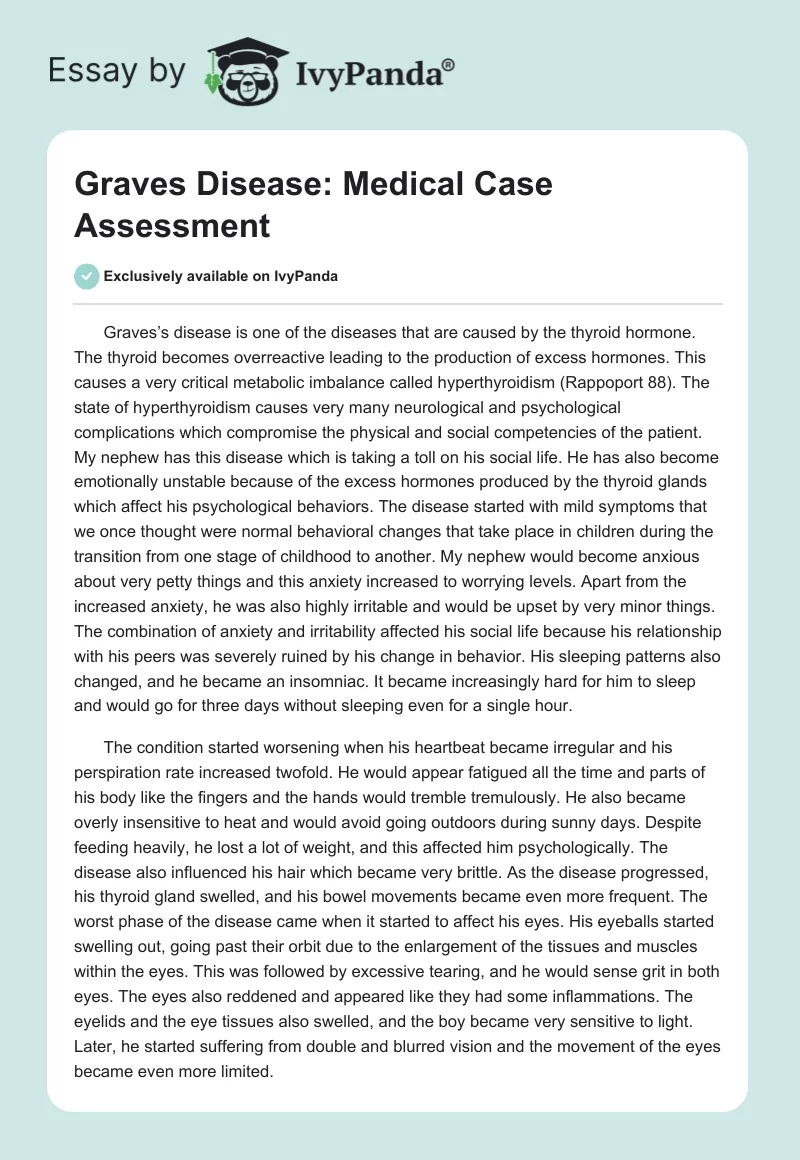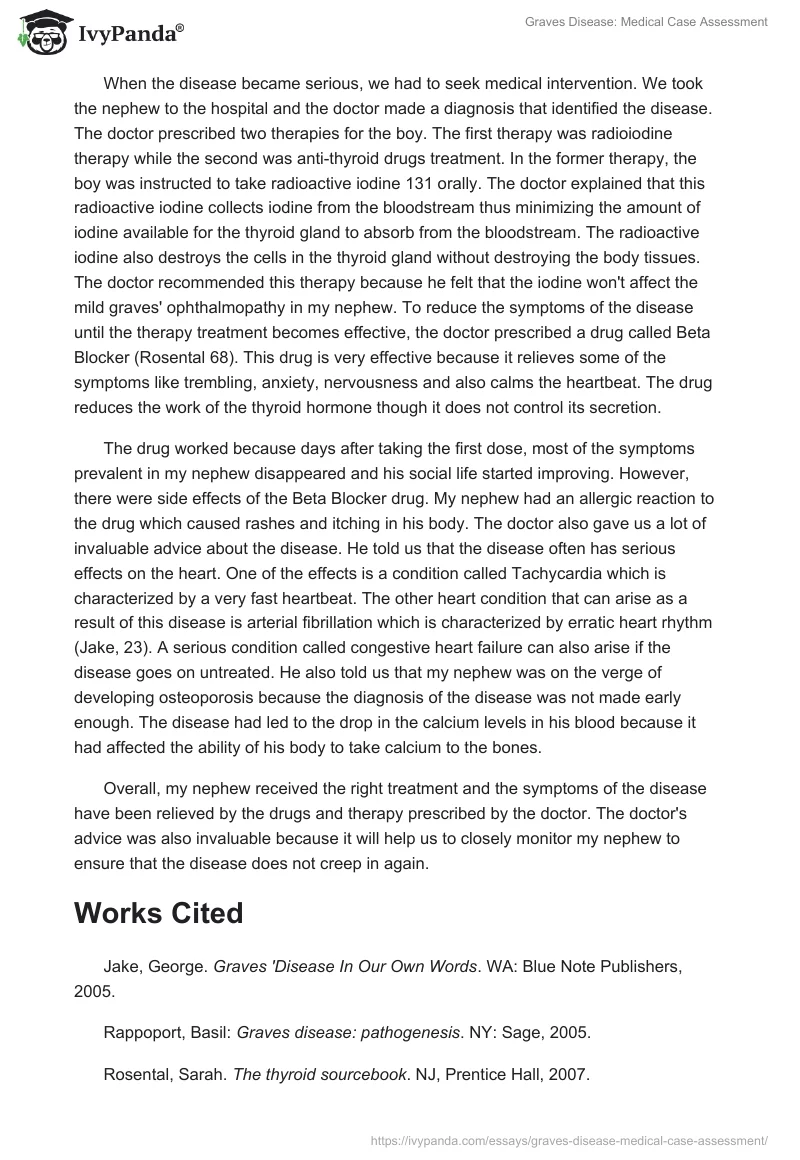Graves’s disease is one of the diseases that are caused by the thyroid hormone. The thyroid becomes overreactive leading to the production of excess hormones. This causes a very critical metabolic imbalance called hyperthyroidism (Rappoport 88). The state of hyperthyroidism causes very many neurological and psychological complications which compromise the physical and social competencies of the patient. My nephew has this disease which is taking a toll on his social life. He has also become emotionally unstable because of the excess hormones produced by the thyroid glands which affect his psychological behaviors. The disease started with mild symptoms that we once thought were normal behavioral changes that take place in children during the transition from one stage of childhood to another. My nephew would become anxious about very petty things and this anxiety increased to worrying levels. Apart from the increased anxiety, he was also highly irritable and would be upset by very minor things. The combination of anxiety and irritability affected his social life because his relationship with his peers was severely ruined by his change in behavior. His sleeping patterns also changed, and he became an insomniac. It became increasingly hard for him to sleep and would go for three days without sleeping even for a single hour.
The condition started worsening when his heartbeat became irregular and his perspiration rate increased twofold. He would appear fatigued all the time and parts of his body like the fingers and the hands would tremble tremulously. He also became overly insensitive to heat and would avoid going outdoors during sunny days. Despite feeding heavily, he lost a lot of weight, and this affected him psychologically. The disease also influenced his hair which became very brittle. As the disease progressed, his thyroid gland swelled, and his bowel movements became even more frequent. The worst phase of the disease came when it started to affect his eyes. His eyeballs started swelling out, going past their orbit due to the enlargement of the tissues and muscles within the eyes. This was followed by excessive tearing, and he would sense grit in both eyes. The eyes also reddened and appeared like they had some inflammations. The eyelids and the eye tissues also swelled, and the boy became very sensitive to light. Later, he started suffering from double and blurred vision and the movement of the eyes became even more limited.
When the disease became serious, we had to seek medical intervention. We took the nephew to the hospital and the doctor made a diagnosis that identified the disease. The doctor prescribed two therapies for the boy. The first therapy was radioiodine therapy while the second was anti-thyroid drugs treatment. In the former therapy, the boy was instructed to take radioactive iodine 131 orally. The doctor explained that this radioactive iodine collects iodine from the bloodstream thus minimizing the amount of iodine available for the thyroid gland to absorb from the bloodstream. The radioactive iodine also destroys the cells in the thyroid gland without destroying the body tissues. The doctor recommended this therapy because he felt that the iodine won’t affect the mild graves’ ophthalmopathy in my nephew. To reduce the symptoms of the disease until the therapy treatment becomes effective, the doctor prescribed a drug called Beta Blocker (Rosental 68). This drug is very effective because it relieves some of the symptoms like trembling, anxiety, nervousness and also calms the heartbeat. The drug reduces the work of the thyroid hormone though it does not control its secretion.
The drug worked because days after taking the first dose, most of the symptoms prevalent in my nephew disappeared and his social life started improving. However, there were side effects of the Beta Blocker drug. My nephew had an allergic reaction to the drug which caused rashes and itching in his body. The doctor also gave us a lot of invaluable advice about the disease. He told us that the disease often has serious effects on the heart. One of the effects is a condition called Tachycardia which is characterized by a very fast heartbeat. The other heart condition that can arise as a result of this disease is arterial fibrillation which is characterized by erratic heart rhythm (Jake, 23). A serious condition called congestive heart failure can also arise if the disease goes on untreated. He also told us that my nephew was on the verge of developing osteoporosis because the diagnosis of the disease was not made early enough. The disease had led to the drop in the calcium levels in his blood because it had affected the ability of his body to take calcium to the bones.
Overall, my nephew received the right treatment and the symptoms of the disease have been relieved by the drugs and therapy prescribed by the doctor. The doctor’s advice was also invaluable because it will help us to closely monitor my nephew to ensure that the disease does not creep in again.
Works Cited
Jake, George. Graves ‘Disease In Our Own Words. WA: Blue Note Publishers, 2005.
Rappoport, Basil: Graves disease: pathogenesis. NY: Sage, 2005.
Rosental, Sarah. The thyroid sourcebook. NJ, Prentice Hall, 2007.


